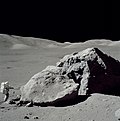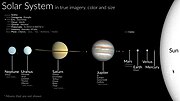 | The geology of solar terrestrial planets mainly deals with the geological aspects of the four terrestrial planets of the Solar System – Mercury, Venus... 44 KB (5,594 words) - 04:30, 22 April 2024 |
 | topics as determining the properties and processes of the internal structure of the terrestrial planets, and also looks at planetary volcanism and surface... 19 KB (1,083 words) - 16:08, 4 April 2024 |
Lists of astronomical objects Geology of solar terrestrial planets Planetary nomenclature Planetary geology List of extraterrestrial dune fields List of tallest... 4 KB (460 words) - 18:52, 26 December 2023 |
 | planets in fiction, see: Planets in science fiction, Stars and planetary systems in fiction and Fictional planets of the Solar System List of planet types... 8 KB (781 words) - 19:19, 18 April 2024 |
phenomena See also: Geology of solar terrestrial planets – Geology of Mercury, Venus, Earth, Mars and Ceres Planetary geology – Geology of astronomical objects... 9 KB (1,335 words) - 16:11, 4 April 2024 |
 | Mars (redirect from Planet Mars) classified as a terrestrial planet and is the second smallest of the Solar System's planets with a diameter of 6,779 km (4,212 mi). In terms of orbital motion... 208 KB (18,892 words) - 02:16, 21 April 2024 |
 | Engineering geology is the application of geology to engineering study for the purpose of assuring that the geological factors regarding the location,... 13 KB (1,561 words) - 17:42, 14 March 2024 |
 | comprised a very small fraction of the solar nebula, the terrestrial planets could not grow very large. The giant planets (Jupiter, Saturn, Uranus, and... 204 KB (20,492 words) - 18:47, 23 April 2024 |
Geochemistry (redirect from History of geochemistry) recovered on Earth). The planets of the Solar System are divided into two groups: the four inner planets are the terrestrial planets (Mercury, Venus, Earth... 57 KB (7,063 words) - 06:41, 26 November 2023 |
The presence of water on the terrestrial planets of the Solar System (Mercury, Venus, Earth, Mars, and the closely related Earth's Moon) varies with each... 21 KB (2,678 words) - 11:31, 3 December 2023 |
 | accretion. The Solar System has at least eight planets: the terrestrial planets Mercury, Venus, Earth, and Mars, and the giant planets Jupiter, Saturn... 195 KB (20,575 words) - 18:51, 20 April 2024 |
 | of Neptune Exploration of Pluto Solar System models Formation and evolution of the Solar System – Nebular hypothesis Terrestrial planets Iron planets... 11 KB (1,024 words) - 23:13, 11 April 2024 |
 | crust. It forms from solidification of a magma ocean. Toward the end of planetary accretion, the terrestrial planets likely had surfaces that were magma... 11 KB (1,375 words) - 05:07, 22 April 2024 |
 | Weathering (redirect from Salt wedging (geology)) Thermal stress weathering can be caused by any large change of temperature, and not just intense solar heating. It is likely as important in cold climates as... 43 KB (5,325 words) - 14:32, 1 April 2024 |
 | Erosion (redirect from Erosion (geology)) Steve G. (2008). "Terrestrial systems". In Perrow Michael R.; Davy, Anthony J. (eds.). Handbook of Ecological Restoration: Principles of Restoration. Cambridge... 61 KB (6,925 words) - 10:23, 20 April 2024 |
 | Earth (redirect from Planet of Water) Bill (16 July 2006). "Earth". The Nine Planets, A Multimedia Tour of the Solar System: one star, eight planets, and more. Retrieved 9 March 2010. Monroe... 194 KB (18,073 words) - 03:18, 24 April 2024 |
 | the eight classical planets of the Solar System. The prototypical dwarf planet is Pluto, which for decades was regarded as a planet before the "dwarf"... 96 KB (8,944 words) - 06:25, 23 April 2024 |
 | Planetary habitability (redirect from Habitability of planets) which drive the orbital evolution of terrestrial planets. Data collected on the orbital eccentricities of extrasolar planets has surprised most researchers:... 112 KB (13,242 words) - 22:29, 19 April 2024 |
 | history of life, and the Earth's past climates. Geologists broadly study the properties and processes of Earth and other terrestrial planets. Geologists... 87 KB (9,583 words) - 08:18, 13 April 2024 |
 | Facies (redirect from Facies (geology)) In geology, a facies (/ˈfeɪʃɪ.iːz/ FAY-shih-eez, US also /ˈfeɪʃiːz/ FAY-sheez; same pronunciation and spelling in the plural) is a body of rock with distinctive... 7 KB (680 words) - 17:38, 8 February 2024 |
 | Venus (redirect from Venus (Planet)) about Venus being a habitable or inhabited planet. Venus is one of the four terrestrial planets in the Solar System, meaning that it is a rocky body like... 214 KB (19,468 words) - 08:17, 20 April 2024 |
 | Exoplanet (redirect from Planets of other solar systems) An exoplanet or extrasolar planet is a planet outside the Solar System. The first possible evidence of an exoplanet was noted in 1917 but was not then... 146 KB (15,828 words) - 18:56, 20 April 2024 |
 | Earth's energy budget (redirect from Energy budget of Earth) atmospheric and terrestrial radiation (shifted to longer electromagnetic wavelengths) to space about the same amount of energy as it receives via solar insolation... 57 KB (6,006 words) - 15:52, 8 April 2024 |







